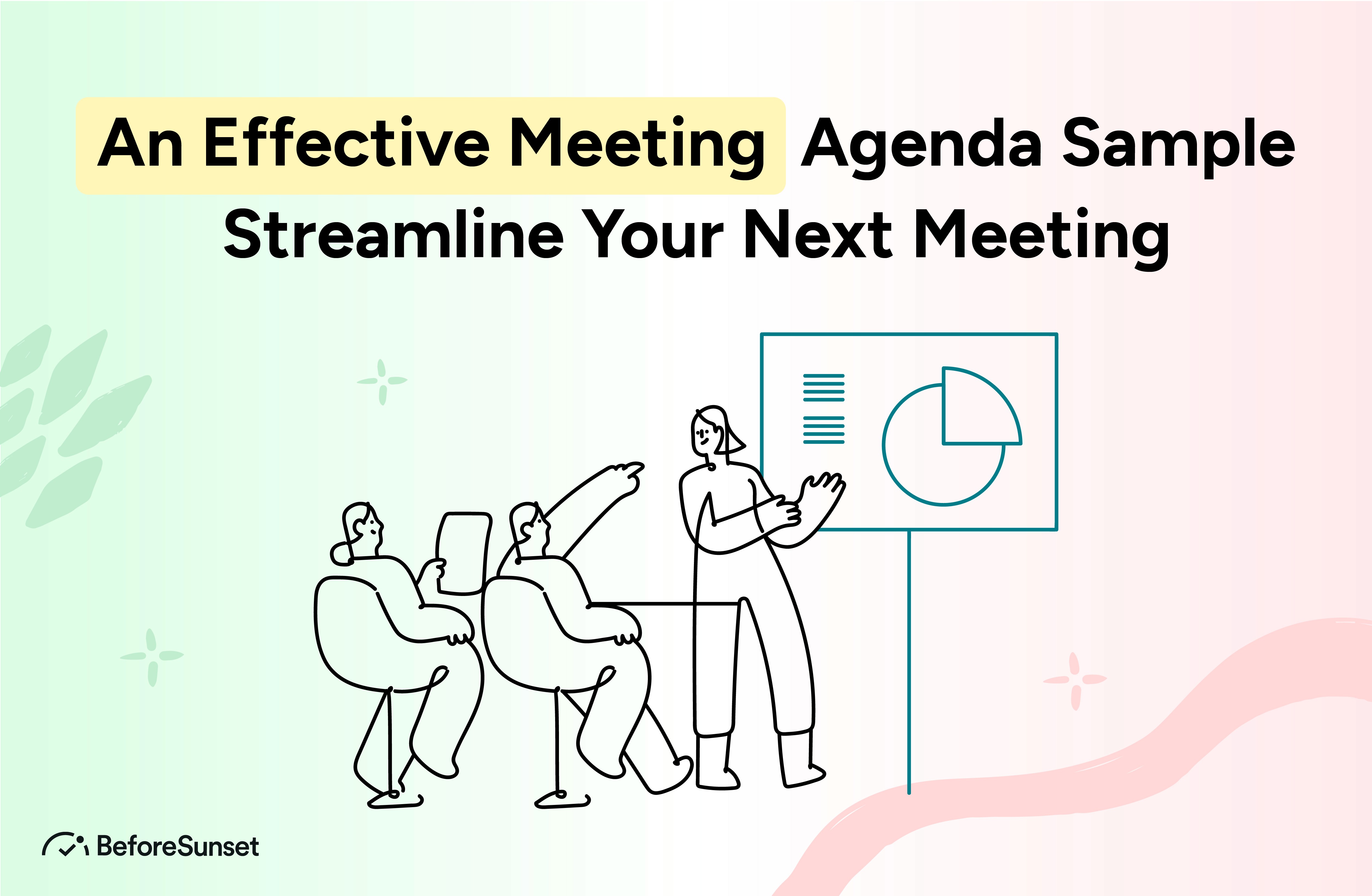Meetings are a cornerstone of collaboration and decision-making in both professional and personal spheres. However, all too often, we've found ourselves trapped in poorly planned and aimless gatherings that devour our time and leave us wondering why we were there in the first place. This is where the importance of well-structured meeting agendas comes into play.
Poorly planned meetings can be a source of frustration and inefficiency. They lead to confusion, miscommunication, and, ultimately, wasted time that could have been better spent on more meaningful tasks. Participants often leave such meetings with a sense of bewilderment, wondering why they were called in the first place.
In this blog post, I'm going to delve into the world of effective meeting agendas, shedding light on how they can transform your meetings from time-wasting endeavors into productive, purpose-driven sessions. But before we embark on this journey, let's take a moment to acknowledge the dark side of disorganized meetings.
You might also like:
Definition of a Meeting Agenda
A meeting agenda is a structured outline or plan that serves as a roadmap for a meeting. It is a concise document that details the topics to be discussed, the order in which they will be addressed, and the allocated time for each item. Think of it as a meeting's itinerary, a clear and deliberate guide to ensure that the meeting stays on track, achieves its objectives, and maximizes productivity.
A well-crafted meeting agenda typically includes essential information such as the meeting date, time, and location, a list of participants or attendees, the main objectives or goals of the meeting, and a breakdown of agenda items. By providing a clear structure for the meeting, it enables participants to prepare, engage, and contribute effectively, ultimately leading to more purposeful and time-efficient gatherings.
In essence, a meeting agenda is a vital tool for improving the quality and efficiency of meetings, making them a valuable investment of time and resources rather than a drain on them.

1. Meeting Date, Time, and Location:
Clearly specify the date, start and end times, and the location or platform where the meeting will take place. This ensures everyone knows when and where to participate, reducing confusion and late arrivals.
2. List of Attendees:
Include a list of participants who are expected to attend the meeting. This helps in identifying who should be present and who can provide input on the topics at hand. It also helps participants prepare and understand their roles in the meeting.
3. Meeting Objectives and Goals:
State the main objectives and goals of the meeting. What do you intend to accomplish during this meeting? Defining clear objectives gives purpose to the gathering and helps participants focus on what needs to be achieved.
4. Agenda Items and Topics:
Enumerate the specific topics or agenda items to be discussed during the meeting. These are the key subjects that need attention. Each item should be clear and concise, providing participants with an understanding of what to expect.
5. Time Allocated for Each Agenda Item:
Assign a realistic time frame for each agenda item. This ensures that the meeting stays on track and doesn't overrun. Time allocation also encourages efficient discussions, as participants are mindful of staying within the allotted time.
6. Assigned Responsibilities:
If specific participants are responsible for leading or presenting on certain agenda items, make that clear. Assigning responsibilities ensures that the meeting runs smoothly and that everyone knows their role in advancing the discussion.
Checklist for Creating a Comprehensive Agenda:

Creating a comprehensive meeting agenda is easier when you follow a checklist. Here's a simple guide to help you craft an effective agenda:
Date, Time, and Location: Clearly specify when and where the meeting will be held.
List of Attendees: Create a list of expected participants.
Meeting Objectives and Goals: Define the main purposes of the meeting.
Agenda Items and Topics: Enumerate the specific subjects to be discussed.
Time Allocation: Assign realistic time frames for each agenda item.
Assigned Responsibilities: Designate who will lead or present on each topic.
Review and Distribute: Ensure that the agenda is reviewed for clarity and then distributed to participants in advance of the meeting.
By adhering to these components and checklist, you can craft a meeting agenda that not only keeps meetings organized and on track but also ensures that the objectives are met efficiently, making your meetings more productive and purposeful.
Benefits of Having a Meeting Agenda Sample
The benefits of having an agenda for meetings are numerous and contribute to more effective and productive gatherings. Here are some of the key advantages:
Clarity and Focus: Meeting agendas provide clarity by outlining the specific topics to be discussed. This clarity helps participants stay focused on the meeting's objectives, reducing off-topic discussions and tangents.
Efficient Use of Time: By allocating time for each agenda item, meetings become more time-efficient. Participants are aware of time constraints, which encourages them to stay on track and use their time wisely.
Improved Preparation: Meeting agendas give participants the opportunity to prepare in advance. When attendees know what topics will be covered, they can gather relevant information and be better equipped to contribute to discussions.
Enhanced Participation: Clear agendas encourage active participation as attendees can come prepared with insights, questions, and solutions. This increases engagement and the likelihood of achieving meeting goals.
Accountability: Assigning responsibilities for each agenda item ensures that participants are accountable for their contributions. This accountability leads to more ownership and commitment to meeting outcomes.
Prioritization: Agendas help prioritize discussion topics, ensuring that the most important and urgent matters are addressed first. This prevents crucial issues from being overshadowed by less important ones.
Consistency: By following a consistent agenda format for recurring meetings, participants can easily adapt to the structure. This consistency streamlines the meeting process and minimizes confusion.
Progress Tracking: Meeting agendas can include action items or follow-up tasks. These reminders help track progress and ensure that decisions made during the meeting are acted upon afterward.
Reduced Stress: When meetings have a clear agenda, participants are less likely to feel anxious or unprepared. This reduction in stress fosters a more positive and productive meeting environment.
Meeting Effectiveness: Ultimately, agendas contribute to more effective meetings. They help achieve the intended meeting goals, reduce wasted time, and enhance decision-making processes.
Structuring Your Meeting Agenda
Structuring your meeting agenda is an art that can significantly impact the flow and effectiveness of your meetings. In this section, we'll explore different approaches to structuring a meeting agenda and provide insights into when to use each one.

1. Chronological Order: A Step-by-Step Agenda
Structure:
Start with welcoming and introductory items.
Follow with the agenda items in the order they are to be discussed.
Conclude with closing remarks, action items, and future meeting scheduling.
When to Use:
Ideal for routine or straightforward meetings with a clear sequence of discussion.
Well-suited for training sessions, project status updates, and team check-ins.
2. Priority-Based: Focus on What Matters Most
Structure:
Prioritize agenda items based on their importance or urgency.
Start with the most critical topics and work your way down.
Conclude with any items that are less pressing.
When to Use:
Best for meetings where not all topics are equally important.
Useful in strategic planning sessions or crisis management meetings.
3. Hybrid Approach: Balancing Chronology and Priority
Structure:
Begin with welcoming and introductory items.
Follow with the most critical or time-sensitive agenda items.
Continue with the rest of the topics in chronological order.
Conclude with action items, closing remarks, and future meeting scheduling.
When to Use:
Ideal for meetings that have both routine elements and critical discussions.
Effective for regular team meetings where some items are standard while others are project-specific.
4. Thematic: Grouping Similar Topics
Structure:
Categorize agenda items into thematic groups.
Discuss all items within a theme together.
Conclude with any general or action items.
When to Use:
Best for meetings where topics are related or can be grouped logically.
Suitable for brainstorming sessions, workshops, or training on multiple related subjects.
5. Interactive: Mix Discussions and Activities
Structure:
Include interactive activities or discussions within the agenda.
Intersperse these activities between traditional agenda items.
Conclude with any action items or key takeaways.
When to Use:
Ideal for creative or team-building meetings.
Effective for brainstorming sessions, workshops, or training that involves group exercises.
6. Roundtable: Rotating Discussion Roles
Structure:
Assign different participants as discussion leaders for various agenda items.
Each participant leads the discussion for their assigned item.
Conclude with action items and future meeting scheduling.
When to Use:
Suitable for participatory or democratic decision-making.
Effective for team-building meetings and smaller group discussions.
7. Custom: Tailored to Meeting Goals
Structure:
Create a unique structure that best aligns with the meeting's objectives.
Consider the nature of the topics and the preferences of the participants.
When to Use:
When no pre-defined structure fits the meeting's specific needs.
Adapt the structure to accommodate the unique requirements of the meeting.
Incorporating the right structure into your meeting agenda can make a significant difference in meeting outcomes. Consider the nature of your meeting, the participants involved, and the objectives you want to achieve when selecting the most appropriate agenda structure. By doing so, you'll ensure that your meeting agenda is a powerful tool that enhances communication, engagement, and overall productivity.
Tips and Best Practices for Conducting Productive Meetings
Productive meetings are essential for achieving organizational goals and ensuring efficient collaboration. Here are some best practices for conducting such meetings:
1. Staying on Topic
Use a Clear Meeting Agenda: Begin by creating a well-structured meeting agenda. Clearly outline the topics to be discussed, and ensure everyone has access to it in advance.
Set Ground Rules: At the start of the meeting, establish ground rules for staying on topic. Encourage participants to stick to the agenda and defer unrelated discussions for later.
Moderate Effectively: As the meeting host, take on the role of a moderator to keep discussions on track. Politely steer conversations back to the agenda when they deviate.
2. Time Management
Adhere to Time Slots: Assign specific time slots to each agenda item and stick to them. Use a timer to signal when it's time to move on to the next topic.
Prioritize Agenda Items: If time constraints are looming, prioritize agenda items based on their importance. Some discussions may need to be deferred or shortened.
Consider Technology: Use time management tools, such as BeforeSunset.AI, to allocate time for each agenda item, ensuring that meetings don't overrun.
3. Encouraging Participation
Create a Welcoming Atmosphere: Foster an inclusive environment where participants feel comfortable sharing their ideas and opinions.
Engage Everyone: Encourage all participants to contribute by asking open-ended questions, seeking input from quieter members, and giving recognition for valuable insights.
Use Collaboration Features: Tools like BeforeSunset.AI offer collaborative features that allow participants to engage in real-time discussions, making it easier for everyone to participate, even in virtual meetings.
4. Following up on Action Items
Assign Responsibilities: Clearly assign tasks and responsibilities during the meeting. Use the meeting agenda or dedicated action item sections for this purpose.
Set Deadlines: Ensure that action items have clearly defined deadlines. Participants should know when their tasks are due.
Document Minutes: Keep meeting minutes or notes that summarize what was discussed, decisions made, and action items assigned. Share these with participants after the meeting.
How BeforeSunset AI Can Assist with These Best Practices
BeforeSunset AI offers a comprehensive solution to streamline meeting preparation, execution, and follow-up. Here's how it can assist in implementing the above best practices:
Staying on Topic: BeforeSunset AI helps you create and share clear meeting agendas, ensuring that all participants know the purpose of the meeting and the topics to be discussed. Its time management features help keep discussions on track.
Time Management: BeforeSunset AI can allocate specific time slots for each agenda item, allowing participants to manage their time effectively and ensuring that meetings end on time.
Encouraging Participation: The platform offers real-time collaboration features, making it easy for participants to engage in discussions, share their thoughts, and provide input, even in virtual meetings.
Following up on Action Items: BeforeSunset AI allows you to assign responsibilities, set deadlines, and document action items, making it easier to track and follow up on tasks after the meeting.


